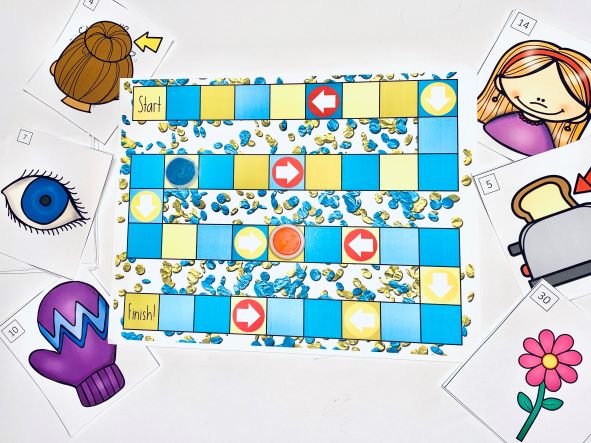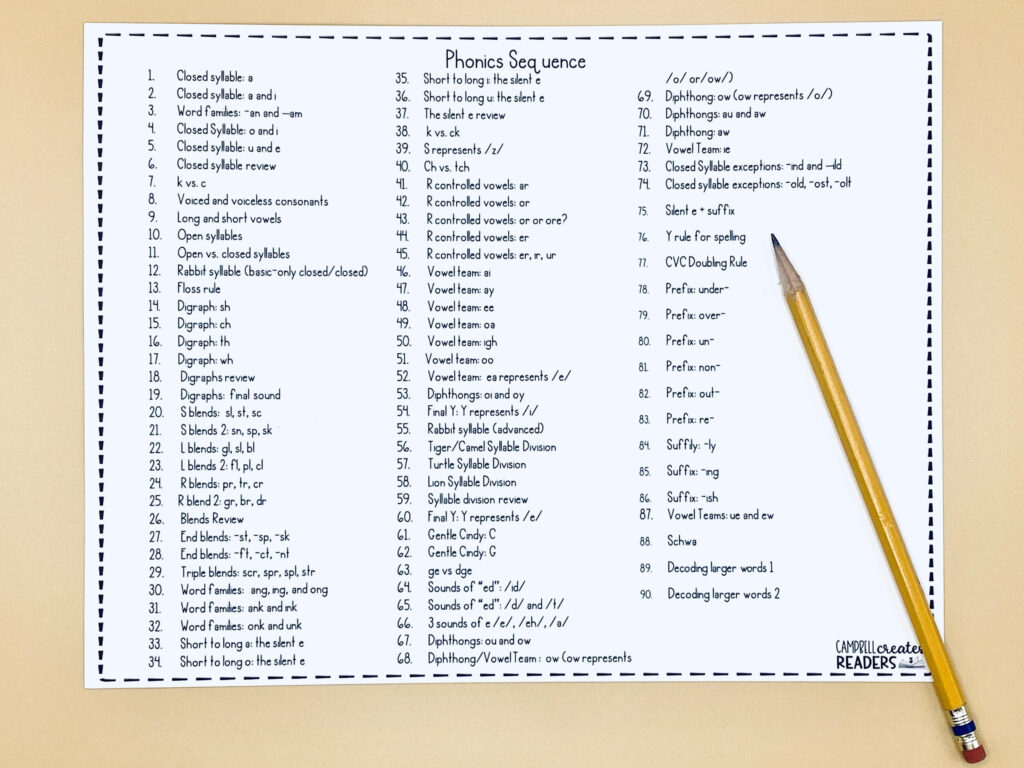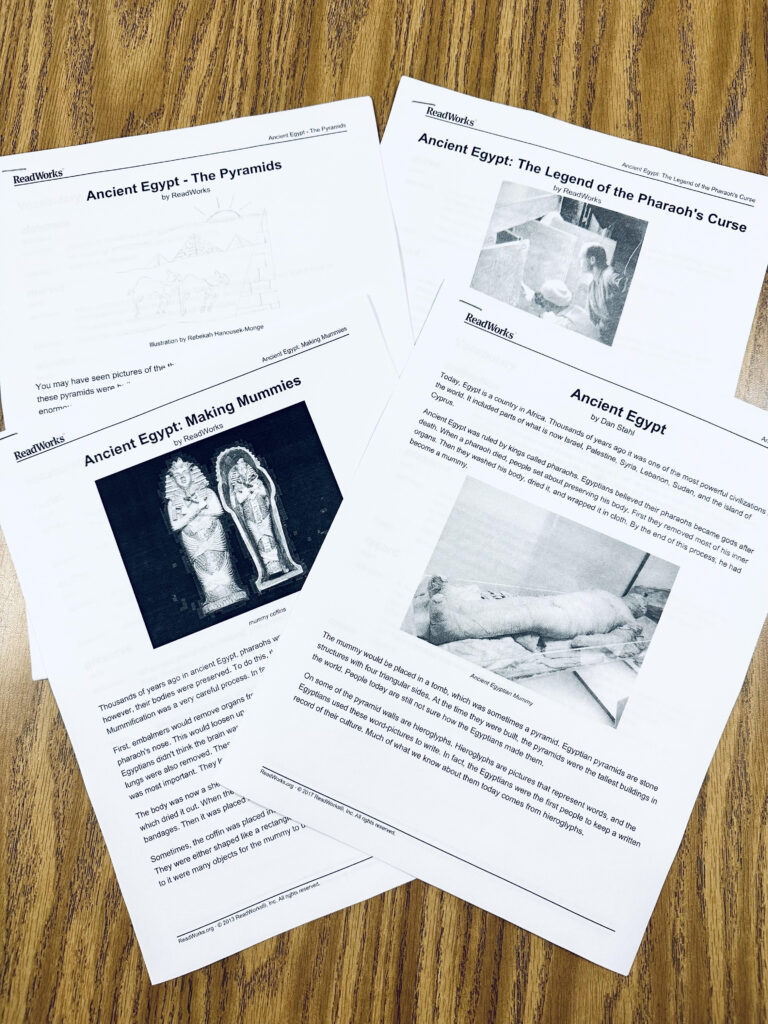
Share This:
We’ve shifted away from small groups based off guided reading levels, but what do we do now? In the past, I’ve shared what I do in my own intervention small groups. I’ve detailed the nitty-gritty, step-by-step actions I take for kindergarten, first-third grade, and upper elementary. Today, I want to zoom out a little bit and give general guidelines about where you should target your instruction in your own small groups and how we decide which students go into which group.
Universal screeners are not enough to tell us what skills we need to work on in small group. Remember, a universal screener is intended to be a snapshot, a quick temperature check into the academic health of a child. While a universal screener can tell us if a child is at risk of reading failure, it doesn’t tell us the specific skills a child needs to work on.
In order to determine that, we will need to use a diagnostic. A spelling inventory can give you great insight into the skills a child does or does not have, as well as a phonics screener. There are a variety of diagnostics out there, and you can find many for free. This is one area where I stay away from TPT. Unless the person creating assessments is well versed in the assessment creation process, it is much better to get your assessments from a company that you trust.
Once we have administered our universal screeners and I have followed up with some additional diagnostics, then I start planning my groups. All my groups have one of the following instructional foci: phonemic awareness and letter sounds; basic phonics; or morphology and comprehension. Let’s explore each.
I have a vague memory in my mind of my kindergarten intervention groups before my instruction became aligned with the science of reading. I remember using the “orange kit” (If you know, you know). I was SO PROUD of my students because they were reading REAL books every single day. I thought the more times they could read books, the more we could approximate this thing called reading, the better off we would be.
Now I know, those are not the things that will move these students the furthest. So let’s talk about what WILL move them along.
If our students do not have their letter names and sounds, that is of paramount importance. In Kindergarten and first grade, the two biggest indicators of future reading achievement are phonemic awareness and letter sound knowledge.
For students that are in this group, work to systematically teach, reinforce, and review their letter names and sounds. Add in phonemic awareness instruction. You can find more details about this kind of instruction here.
A note about phonemic Awareness: The evidence is very clear surrounding phonemic awareness: phonemic awareness is more effective when letters are added. But for this earliest group, they may not know any letters.

This is the only group where I consistently do phonemic awareness practice without adding letters. I use parts of Heggerty to accomplish this. Because these kiddos are at the very beginning stages of their academic career, oral-only phonemic awareness activities are beneficial. We add letters as soon as we can, however.
This is the group that is probably the hardest to reimagine after giving up your guided reading groups. I remember telling myself, “I just need to get them to a guided reading letter J by the end of first grade,” as though if they could read a book that had the guided reading level J slapped on it everything would be fixed.
Before I learned about structured literacy, there was a year in my classroom where 12 out of 24 students failed their universal screener at the end of the year. I didn’t know better than guided reading, and the results were clear. While the paper may have shown that they failed the test, the failure was really on me. But, now I know better, and I will always work to do better for the sake of my students.
If you have children who need basic sound-symbol correspondences, the first thing you need is a solid scope and sequence. If your district already has one, lean into it and use that. If not, I have a free one you can use.

A scope and sequence is important because this will help lead your instruction and give you the skills you need to teach. The problem with things like guided reading is that any phonics skills taught are taught incidentally—not in a systematic way. A phonics sequence can help ensure your instruction is systematic.
If you want more details on the instruction for this group, you can find it here. Just know, above all else, the children in this group will need exposure to the skills you have taught them. Always ask yourself, “Are they reading and spelling enough to become proficient readers?” Decodable texts and review activities will be a large part of your instruction.
I used to think my small groups for comprehension needed to be skill based–let’s focus on main idea, then supporting details, then character traits.
And I was using chapter books that took us months to get through. You kind of lose your stamina for something when it takes you 3 months to read the book. And when the only books you have access to are yellow and smelly, it just doesn’t give kids that passion for reading. But, I just didn’t know any better way to reach them.
After reading Natalie Wexler’s The Knowledge Gap*, my world shifted. For the first time ever, I felt like understood what these students needed to improve their reading.
If your students need this instruction, this is the time to build their understandings about the world, and to give them the vocabulary they need to understand it. When basic decoding is not the main barrier to comprehension, small group should be focused on helping students gain background knowledge and vocabulary.

Instead of using long chapter books, I have begun to do units based on science and social studies topics. I will use texts from places like ReadWorks that can be read in a single session. AND READWORKS IS FREE!!!!!! In-between the nonfiction units, we will often read short fiction texts. Reading A-Z has some great fiction series that kids love. They are high-quality fiction that can be read in 1-2 settings. This is not free, but well worth the $100 a year to have access to so many texts. (In the past, our PTA has paid for it, and we’ve also used instructional funds)
Head here to learn more about the nitty-gritty details of my intervention groups for these kiddos.
I don’t talk about fluency a lot. There’s a lot of people out there more passionate about it than I am. I’ve grappled with why I don’t have a fluency group, and I think I’ve finally figured out a way to articulate it.
It’s not because I don’t believe fluency is critical. I 100% believe that fluency is necessary to ensure students become proficient readers.
It’s just that I don’t see fluency as being a group that is separate from one of my other groups. In Reading Teacher’s Top Ten Tools, Deb Glaser shares that 80% of fluency issues are actually decoding issues.
So, if the fluency is a decoding issue, then I am putting them in a phonics group. In that group, I will ensure that they are explicitly taught the code, and then give them the practice they need to boost their fluency.
If decoding is NOT an issue, then I’m putting them in my comprehension group. I may add some additional targeted fluency exercises, but I am not spending 30 minutes targeting fluency. It would be a part of what I’m already doing.
I hope this outline can help you think in terms of where to place each of your students into a small group. Now that we don’t use guided reading levels, we need another way to reach our students “on their level.” It’s just the level will be specific skill deficits they have, not a text that someone randomly slapped a letter on.
Share This:

Savannah Campbell is a K-5 reading specialist. She has taught her entire 12-year teaching career at the school she went to as a child. She holds two master’s degrees in education from the College of William and Mary. Savannah is both Orton-Gillingham and LETRS trained. Her greatest hope in life is to allow all children to live the life they want by helping them to become literate individuals.

Savannah Campbell is a K-5 reading specialist. She has taught her entire 12-year teaching career at the school she went to as a child. She holds two master’s degrees in education from the College of William and Mary. Savannah is both Orton-Gillingham and LETRS trained. Her greatest hope in life is to allow all children to live the life they want by helping them to become literate individuals.
Feeling overwhelmed with all the terminology out there? Want to know the key terms all teachers need to teach phonics? In this FREE Rules of English cheat sheet, you get a 5 page pdf that takes you through the most important terms for understanding English—you’ll learn about digraphs, blends, syllable types, syllable divisions, and move. Grab today and take the stress out of your phonics prep!
